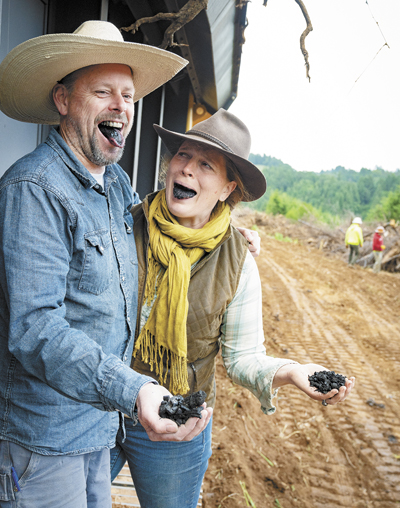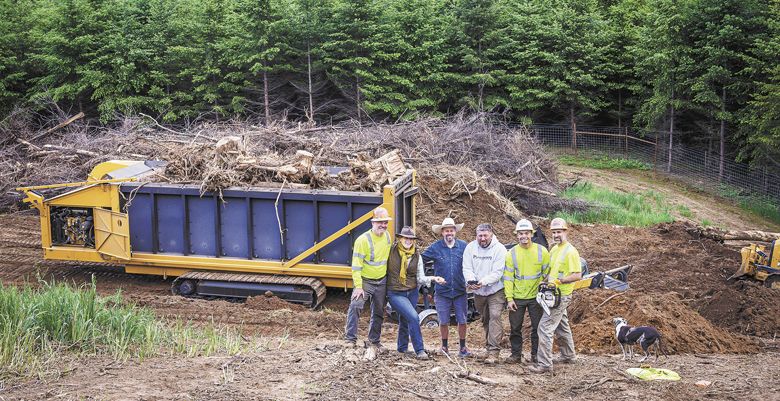Biochar-ged and Ready to Grow
Big Table Farm uses on-site carbonizing technology
This is a tale not unusual to Oregon wine country: You come upon some land you’d like to convert to vineyard, but it’s densely coated in flora, from native fir trees to invasive bushes. The standard procedure? Clear the land and burn the scraps.
For a variety of reasons, open burns now face criticism, or, at the least, questions. As the very real and serious threat called climate change continues to dictate new norms, farmers, especially, examine more closely their environmental footprints. This is to say nothing of the last several growing seasons, both warm and, in a growing number of areas, influenced by wildfires.

Enter the Carbonator-500, a mobile kiln-like device that converts what would normally become ash into biochar, a type of charcoal resulting from the burning of biomass. Unlike a typical pile burn, however, this transformation is contained. The machine, which looks a cross between a giant dumpster and a military tank, heats and processes the debris, leaving a wake of biochar that can be used as natural fertilizer for farms of all kinds.
“It is new technology,” says Brian Beall, the business and product development manager for Blackwood Solutions based in Indiana. “But the air burner technology is not, nor is the concept of biochar.” The company operates in 30 states and remains one of the first outfits to buy a carbonizer. He says he saw the Carbonator-500 at a trade show last year and immediately informed his colleagues.
Biochar has been around since the early days of agriculture. Pre-Columbian groups from the Amazon are believed to have incorporated the matter to improve their yields. They created it by smoldering agriculture waste and then returning it into the soil. European settlers noted the practice when they ultimately arrived.
“The main thing is that it safely and economically disposes of green woody debris,” Beall adds. It’s caught the attention of the forestry industry, with its need for new wildfire prevention approaches amid longer, hotter, drought-parched years.
“There’s a lot of interest,” he says. Beall claims he’s already heard from a number of vineyard management companies, along with the Oregon Wine Board. “It’s been wildly popular.”
Yet, with just a handful of these machines in the mix so far, it’s far from common practice. Beall says production is currently located in Toronto, but the Carbonator-500 soon will be manufactured in New Hampshire. As interest grows in the U.S., the machine will surely face the dual dilemma of cost and short-sightedness — we are, after all, a country still questioning a changing planet, despite living amid the consequences.
“It’s tough to compete with a match,” Beall adds. “We need a fleet to put a dent in what’s going on,” he admits, citing wildfire management and general slash-and-burn approaches in agriculture. “But Oregon is way ahead of the game.”
Of course, getting the machine on location is not exactly easy. It weighs almost 90,000 pounds, requires special transport, and the on-the-job rates aren’t cheap — Beall roughly estimates a working price of about $500 an hour — but in the scheme of things, it’s far from outrageous. Beall explains the technology is efficient, taking on some 20 tons of woody debris per hour.
Big Table Farm near Gaston started its biochar project in mid-May. As of early June, they’re nearing completion of a roughly 13-acre parcel for planting vines. As co-owner Clare Carver suggests, there’s a bit of a learning curve as their brand is the first in the wine trade to clear land in this manner. But she’s already pleased with the results.
“It’s clean environmentally, good for our vineyard site and, lastly, we are making a product.” Carver points out the environmental benefits are twofold, in terms of both emissions and the sequestering of carbon. Sequestering refers to the carbon-capturing ability of various things. In nature, that role is typically played be trees, which gobble up carbon dioxide. When the trees are burned, these emissions are released into the atmosphere. Carbonization makes a clean burn with no particulates.
In terms of products, biochar is already sold around the country, at your local big box home improvement and garden stores for a while already. It’s selling more and more online and there are a slew of producers nationwide that create and sell biochar, for residential, commercial and industrial uses. It’s sought after for all kinds of purposes, from animal feed and building materials to clothing and electronic equipment.
Clare, with husband/winemaker Brian Marcy, plans to use some of the biochar as compost for their garden and fields, as well as sell some. For this working farm, home to free-range livestock, a vineyard and plenty of biodiversity, biochar appears right at home.
“This is about honoring the resources of our farm at every stage and wasting nothing and leaving this land better than we found it,” she says.
Beall says the machine is able to not only neutralize emissions, but also create a net negative impact. In other words, the only by-product is environmentally advantageous. It’s a bit like solar energy and cleanly harnessing more power than you need, only to put the excess back into the system itself for the greater good.
If you haven’t seen this colossal, Ghostbusters-like carbon trap yet, you may soon, especially in Oregon wine country, where vineyard owners take stewardship of land to heart.
For a video of the carbonization process at Big Table Farm, visit bigtablefarm.com.










